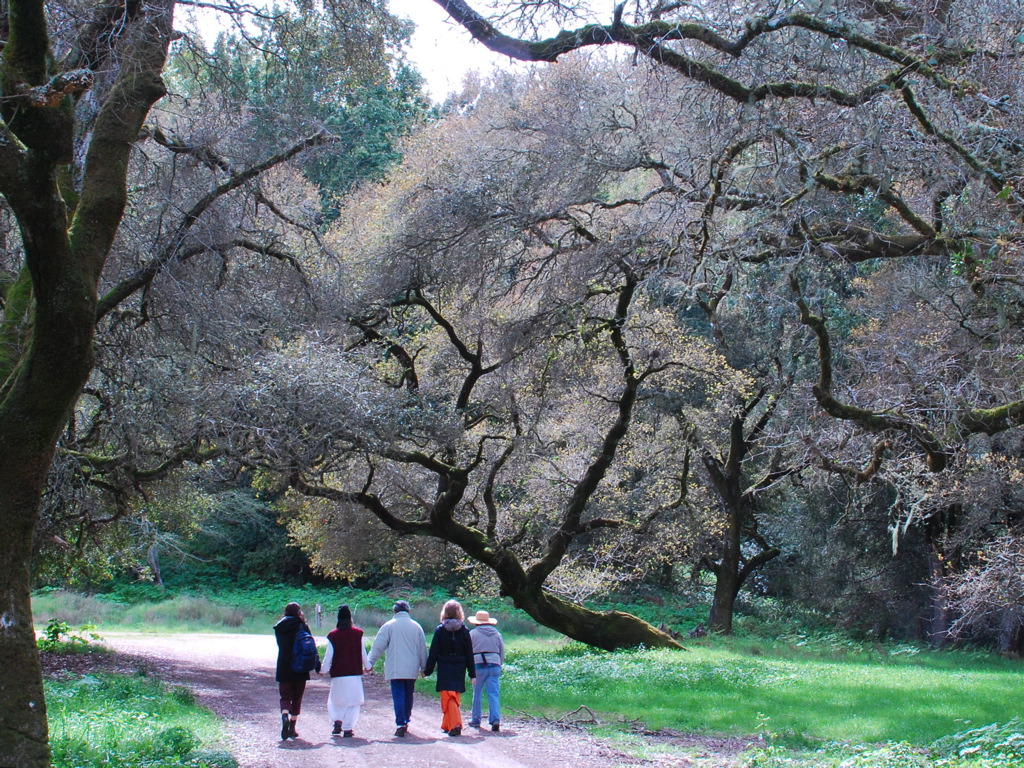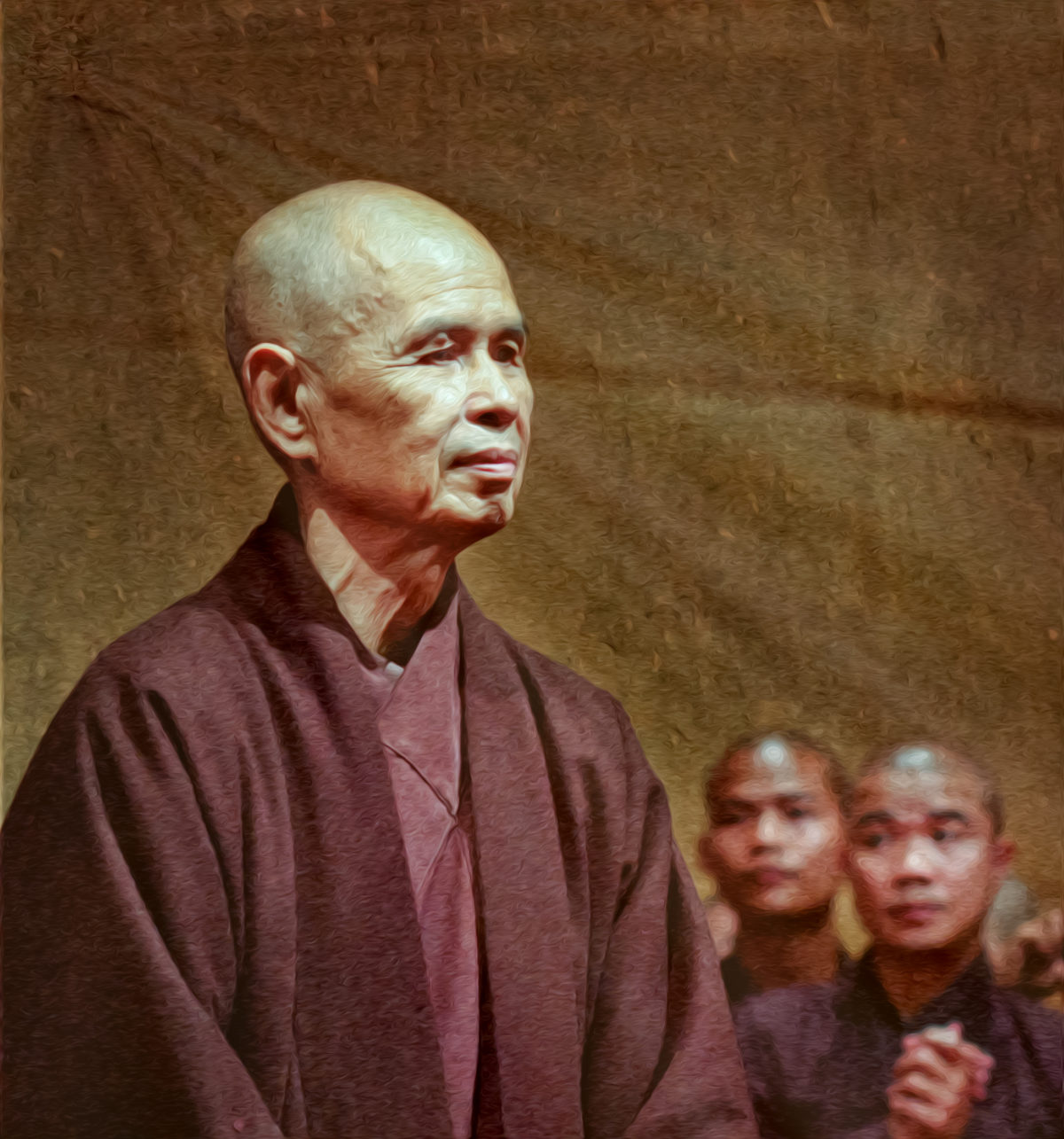
Dharma Talk at the University of Nottingham, United Kingdom
August 17, 2010
Good morning, dear Sangha. Here we are in the University of Nottingham, at our retreat, “Living Mindfully, Living Peacefully.” The other day, we spoke about the Four Establishments of Mindfulness, the four domains of mindfulness. The first is the body, the second is the feelings, and the third is the mind.

Dharma Talk at the University of Nottingham, United Kingdom
August 17, 2010
Good morning, dear Sangha. Here we are in the University of Nottingham, at our retreat, “Living Mindfully, Living Peacefully.” The other day, we spoke about the Four Establishments of Mindfulness, the four domains of mindfulness. The first is the body, the second is the feelings, and the third is the mind. The fourth foundation of mindfulness is the objects of mind, which we will talk about today.
There are also four exercises of mindful breathing to recognize and look deeply into every mental formation. Mind here is a river, and the drops of water that make up the river are mental formations. Mental formations are born, stay for a while, and die. There is hate, anger, fear, despair; there is mindfulness, concentration, love, and so on. We sit on the bank of the river of the mind and recognize, contemplate, and look deeply into each mental formation as it manifests.
The first exercise is to recognize the mental formation. The second exercise is to gladden your mind. If we know how to recognize the good seeds in the bottom of our consciousness and help them to manifest, then we can create joy. When our nourishment and healing are strong, we will be able to handle the afflictions, the despair, the suffering in us. The third exercise is concentrating the mind. With mindfulness, we begin to focus our attention on a particular object. That object might be our joy or our unhappiness, or our pain. That object might be a cloud or a pebble. Using the strength of mindfulness and concentration, we look deeply into the object of our meditation with the power of concentration. The fourth exercise of mindful breathing is to liberate the mind. Salvation, liberation comes not by grace, but by mindfulness and concentration. So with the power of concentration, we can burn away the afflictions that are in us, like a lens concentrates the power of the sun to start a fire.
Four Exercises with Perception
When we work with the object of mind, we deal with the problem of perception. We believe that there is a mind that’s trying to perceive an objective reality. Many scientists of our time still believe that our consciousness is something in here, trying to reach out, to understand the objective reality out there. But in fact, the object of perception and subject of perception cannot be separate. They manifest at the same time. So the object our perception in Buddhism is called the object of mind.
The first exercise that the Buddha proposed in working with perception is contemplating impermanence. Breathing in, I contemplate impermanence. I see everything is changing. Nothing stays the same in two consecutive moments, including my body, my feelings, my perceptions, all my mental formations, and my consciousness. Everything is moving, is changing.
Intellectually that is not difficult to understand, but impermanence should not only be a concept. It should be an insight. Many of us accept the truth of impermanence, but we still behave as if things are permanent. We think of ourselves, our beloved ones, our institutions of society as permanent. And when things are impermanent, and we believe them to be permanent, we suffer. We have to cultivate the insight of impermanence in order to liberate ourselves.
Impermanence is a kind of medicine that can help cure the disease of permanence, but if you get that disease of permanence, it’s very difficult to heal. Suppose the notion of impermanence is like this match, that you must use to produce the flame. It is the flame that we need, and not the match. But without the match, we cannot produce a flame. When the flame is born, it begins to consume the match. So when the insight of impermanence is born, it begins to free you from the notion of impermanence. And that is why in the First Mindfulness Training of the Order of Interbeing, it says not to be idolatrous about any doctrine and teaching, including Buddhist teaching. You have to free yourself from ideologies and doctrines and teachings.
The second exercise is to contemplate non-craving, nonlonging. When we long for something very strongly, when we crave something very strongly, we lose the present moment, we lose ourselves, and all the wonders of life available in the present moment. We lose life. And we know that happiness is not possible when you are sucked into the future, always desiring something. We practice: breathing in, I release my longing, I release my craving for something in the future; breathing out, I contemplate no longing, no craving.
The third exercise is the contemplation of nirvana. Nirvana is our true nature of no birth and no death, no coming, no going, no being, no non-being. Nirvana is the extinction of all notions. In fact, the word nirvana means extinction. This is a very deep, very strong practice of concentration to touch our true nature, the nature of no birth and no death, nirvana.
And the fourth exercise is to release all notions and ideas. The Sanskrit word means to throw away, very strongly; to throw away ideas, notions, concepts.
These four exercises help us to look deeply into the nature of our perception of reality and scientists are trying to do the same thing. They use the language of mathematics, splitting atoms and particles. In the field of meditation, we use the instruments of mindfulness and concentration. Today we are focusing on the exercises using concentration in order to break through to the heart of reality.
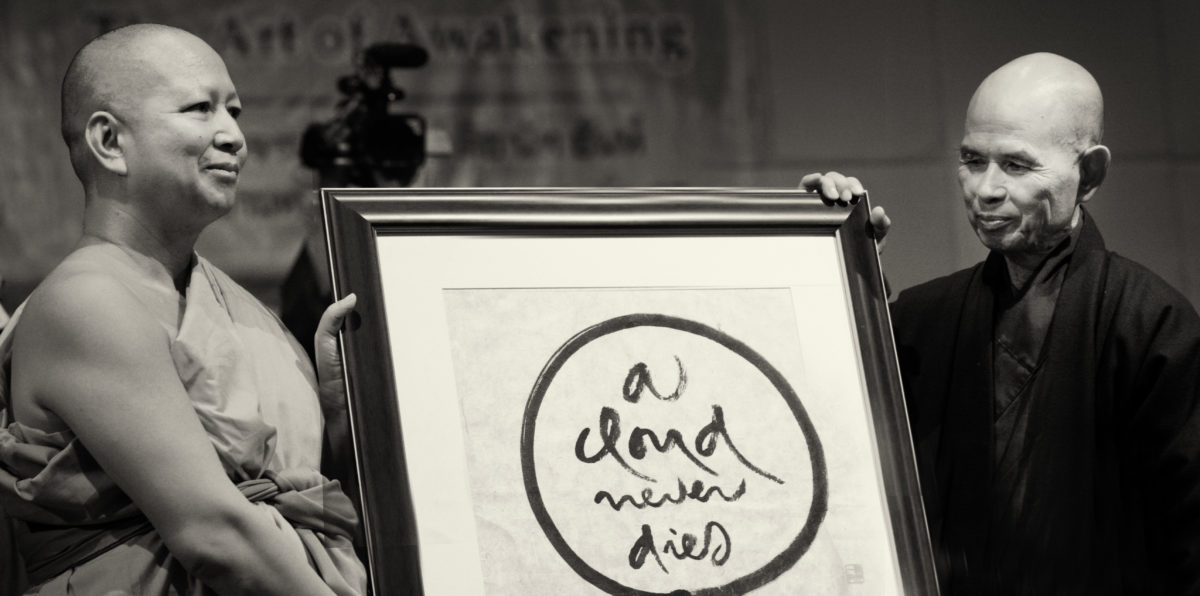
Three Doors of Liberation
The teaching on the three doors of liberation is available in every Buddhist tradition. Also called the three concentrations, they help us to touch the nature of impermanence, of non-longing, of nirvana, and of throwing away.
Emptiness
The first door is called emptiness. Emptiness is a profound teaching. It would be helpful to answer the question: empty of what? This glass is empty of tea, but it’s full of air. So empty is always empty of what? It’s like consciousness is always consciousness of something.
When we look into this beautiful chrysanthemum, we get the impression that this flower is full of the cosmos. Everything in the cosmos is there in the flower, including the cloud, the sunshine, the soil, minerals, time, and space, everything. It looks like the whole cosmos has come together to manifest the flower. The one contains the all.
There is only one thing that is not there: that is a separate entity, a separate existence. The flower is full of the cosmos, of everything else, but the flower is empty of a separate self. No separate self, that is the first meaning of emptiness. You cannot be by yourself. You have to inter-be with the cosmos. And we are all in you. If you look deeply into yourself, you see all of us in you. That is the beginning of the contemplation of interbeing, focusing on the teaching of emptiness.
How do we apply that teaching to our daily life, so it has value for us? When a father looks deeply into his son, he sees that his son is his continuation, that he is fully present in every cell of his son, and making his son suffer is to make himself suffer. He begins to see the truth of interbeing: the father is in the son, and the son is in the father. Thanks to the father, the son can connect with and feel that all the ancestors are in him. When the son walks, all the ancestors walk too. And if the son makes a peaceful, joyful, happy step, all the ancestors in him enjoy that. It’s so kind of you to walk for your ancestors, for your parents. Maybe your parents did not have a chance to learn about walking meditation. And now you walk for your parents, you walk for your ancestors, you walk like a free person on this beautiful planet. So every breath, every step, everything you do can be done with the insight of interbeing, with emptiness.
The nature of the Buddha is also the nature of interbeing. A Buddha is made only of non-Buddha elements. So when you look into the Buddha, you don’t see him as a separate entity, outside of you. You see his nature of interbeing. And when you look at you, you see the same. And that is why you know that the Buddha is not someone out there. The Buddha is right here in you. And because the Buddha is empty of a separate self, and because you are empty of a separate self, that is why communication is very deep. So interbeing is right view. Right view, according to Buddhism, is the abolishment of all views, the absence of all views, so that the insight of impermanence, the insight of emptiness, the insight of interbeing can manifest.
In a relationship of teacher and students, I have always seen that everything I do for myself, I do for my disciples, and the happiness and the suffering of my disciples have to do with my happiness and suffering. We know that we inter-are, and with that kind of awareness, we help each other, we belong to one body, the Sangha. When you have the insight of emptiness, interbeing, you don’t suffer anymore from separation, hate, anger, or despair. And that is the fruit of the contemplation on emptiness.
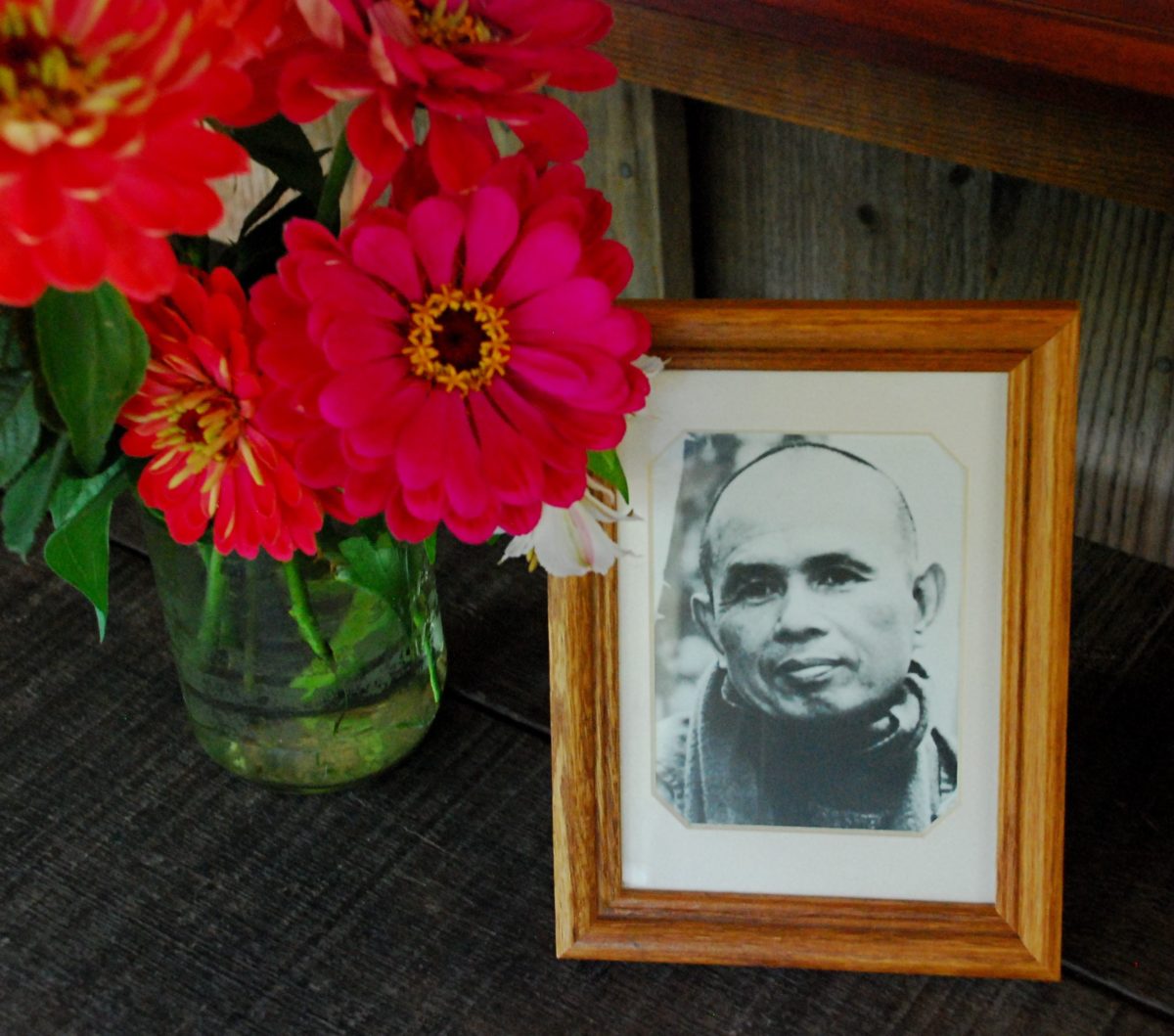
Signlessness
The second door of liberation is the door of signlessness. “Sign” means the appearance, the form. You might be fooled by an appearance, you might be fooled by the form, and that is why we have to train ourselves to see beyond the forms, beyond the signs.
Suppose you have a particular sympathy with a certain cloud. I wrote a poem about a river that was chasing a cloud all day long, and he suffered because clouds are impermanent. When your cloud is no longer there in the sky, you cry, “Oh my beloved cloud, where are you now? I miss you. You have passed from being into nonbeing. I cannot see you anymore.” That’s what we feel when we lose someone who is close to us. Just yesterday, he was still alive, she talked, he walked, she smiled, and today nothing. She looks like she has passed from being into non-being.
But in fact, our cloud is still there. In the beginning, maybe half the cloud has become rain and the other half has become snow. We should train ourselves to see the continuation of our cloud, for it is impossible for a cloud to die. Because to die means from something, you suddenly become nothing. From someone, you suddenly become no one. Looking deeply into the heart of reality, you don’t see anything like that at all. Nothing can be reduced to nothingness. It is impossible to pass from being into non-being. Your beloved one is still somewhere, and if you have the eyes of the bodhisattva, you can still recognize your beloved one in her new appearances, in her new signs. So you have to look beyond the sign, and that is the wisdom of signlessness. In order to remove our grief, to remove our despair and our fear, we should get behind the signs. The Buddha said where there is a sign, there is a delusion, and that is why we should not count on signs. You have to learn how to see things in the light of signlessness.
Thought, speech, and actions: everything you produce in these three aspects continues, and that is your continuation. The Buddhist term is called karma, which means action. If we know how to practice according to the recommendation of the Buddha, with right thinking, right speech, and right action, we are sure to be a beautiful continuation, a happy continuation. And if you don’t know how to do that, if you produce thoughts of anger and fear and hatred, if you speak in a way that destroys, that is not a beautiful continuation.
Nothing is lost, in terms of action. When this body disintegrates, our actions continue us, like a cloud. So to say that you don’t exist after the disintegration of this body, that is not the truth. In the morning, if I have a cup of tea, it will help to make my Dharma talk a little bit more beautiful. So if you look into the Dharma talk, you can see the tea in it. So the tea is not just in the pot; it has a journey, it travels, it has many forms. When you produce thought, speech, and action, your actions continue. We continue always, even after the disintegration of this body.
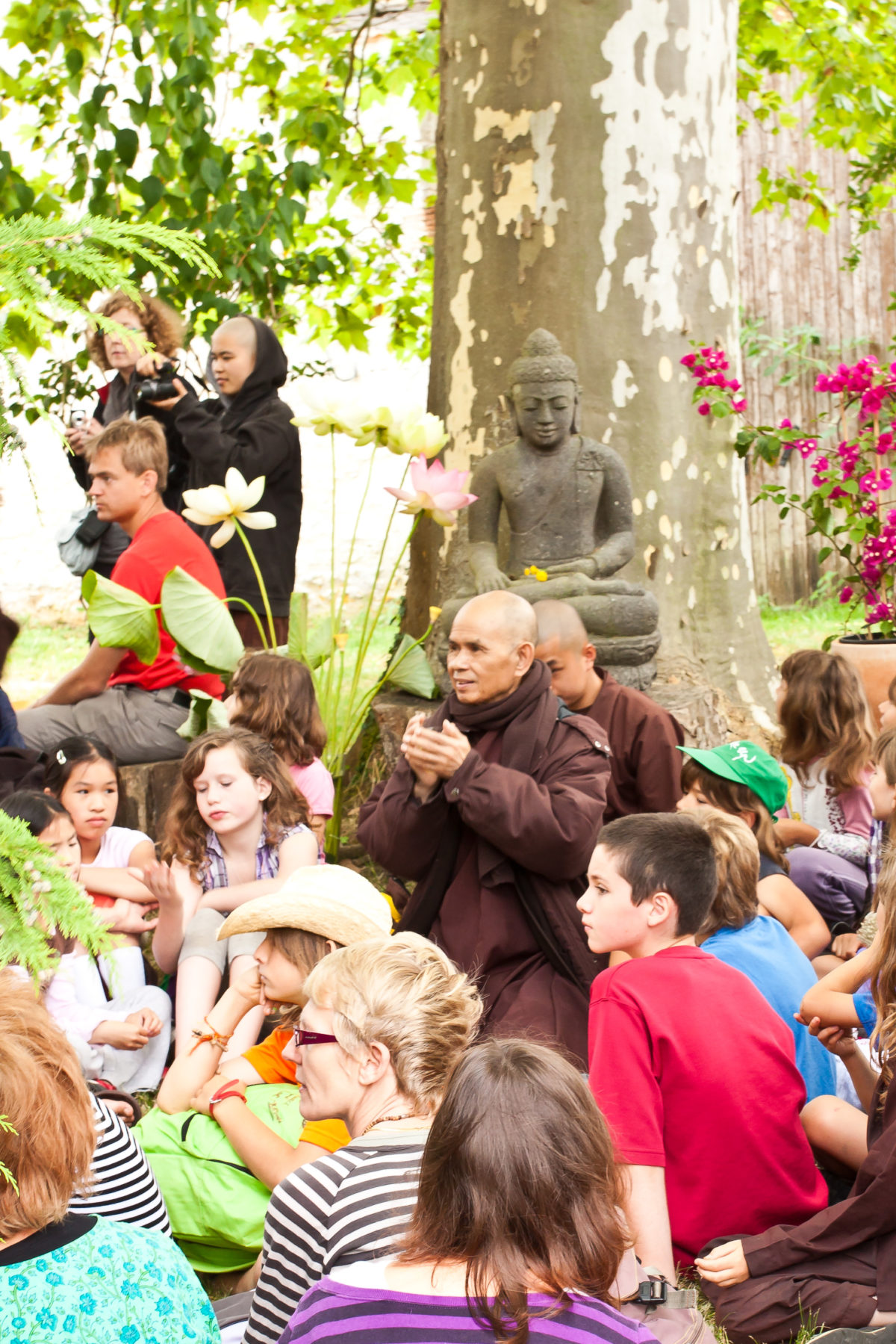
Aimlessness
The third concentration is called aimlessness. The meditation on aimlessness helps us to see that everything is there already. You don’t need to run anymore, and you can let go of your longing, your craving, your desire. When a flower practices aimlessness, she feels that it is wonderful to be herself. This form is a wonderful manifestation of the cosmos. She does not have to be something else. She does not want to become a daffodil or a lotus flower; she is beautiful as she is.
You are already what you want to become. You don’t need to be another person or to run anymore. You are the manifestation of the cosmos. Thanks to the practice of aimlessness, there is no longer any complex, any longing, any desire; there is complete satisfaction, complete fulfillment. What you want to achieve is already there.
Every bodhisattva tradition has the teaching of the three doors of liberation. Practicing these three concentrations, we are able to touch nirvana, our true nature of no birth and no death. We can throw away all notions, like the notions of birth and death, coming and going, and so on.
Suppose we draw a line from left to right, representing the course of time. We pick up one point here, and we call it B, birth. Someone is born in this moment, and they make a birth certificate for him. They forget that that child has been nine months in the womb of his mother. They think that person exists only on point B, but in fact, before B, the child was there. And even before the moment of conception nine months before, the child was in the father and the mother somehow. So this is a moment of continuation. There is no beginning.
And yet we believe that before we were born, we did not exist, and we call this segment non-being. So we think that there will be a moment when we stop being, and we call that D, death. We believe we have passed from non-being into being, and we will pass from being into non-being. So birth and death are two notions that go together. The fourth exercise recommends that you throw away the notion of birth and death, because your true nature is the nature of no birth and no death. Before your cloud appears in the form of a cloud, she had been the water in the ocean, and the heat produced by the sun. A cloud has not passed from non-being into being. So there is no birth; there is only a continuation. Maybe for your next birthday, you will sing, instead of “happy birthday,” “happy continuation day to me.”
Looking into the nature of the notion of being and non-being, you see that being and non-being are just notions; they cannot be applied to reality. You cannot describe a cloud in terms of being and non-being. You cannot describe your beloved one in terms of being and non-being. And you cannot describe God in terms of being and non-being.
When you look at the family album, you can see yourself as a five-year-old boy, or a five-year-old girl. Ask yourself: am I the same person as that little boy? Or I am a different person? You look so different from the little boy, the little girl. Your form, your feelings, your perceptions are quite different. You cannot say that you are identical to that little girl or little boy. Because of impermanence, you have changed into an adult, and if you compare the two persons, you cannot say that you are exactly the same person. Maybe your name remains the same, but in reality, the five skandhas have changed a lot.
You are a continuation of that little boy, or little girl, and the question is: if you are not the same person as that little boy, are you a totally different person? No, you are not a totally different person. You are a continuation of that little boy. It’s like the child is a continuation of his father and mother. The word continuation is good. And that is why the answer cannot be either “the same” or “different.” So there is a pair of notions that should be removed, so that freedom can be possible. After you have removed the notion of birth and death, being and non-being, you remove the notion of sameness and otherness. You are not exactly the same as your father, as the little boy, but you are not entirely another person. So this is the middle way. Transcending both notions, sameness and otherness.
Living mindfully and with concentration, we witness impermanence and we touch the truth of no sameness, no otherness. And it will reduce greatly the suffering and fear in us.
In order to touch the ground of your being, in order to touch your true nature, nirvana, in order to touch God, it is important to learn how to remove these pairs of notions. Because the absence of all these notions means the manifestation of God, of nirvana, of true nature. And classically, there is another pair to consider, that is the pair of coming and going. Where have I come from, and where shall I go? You ask that question for yourself. And you ask that question for your beloved one. “Darling, where have you come from? Why have you left me?”
So the exercises of the practice of the fourth establishment include: contemplating impermanence in order to touch non-self, interbeing; releasing the longing, the craving for something, which cultivates aimlessness; contemplating the ultimate, nirvana, no birth, no death, which releases us from being caught in the appearance, the forms of things. It is with instruments such as the three doors of liberation that you can touch directly your true nature. And then you will be able to throw away all the notions that are at the foundation of your fear and despair and separation.


